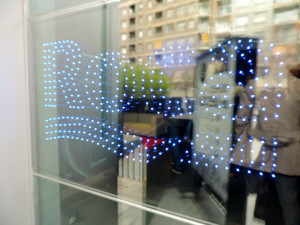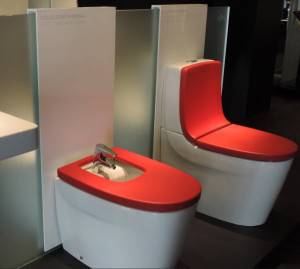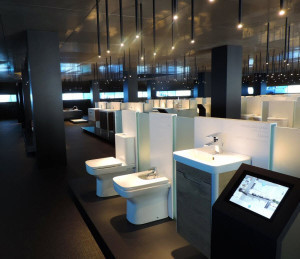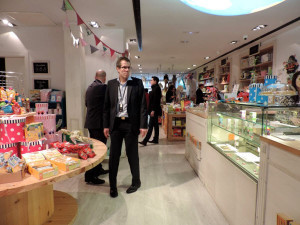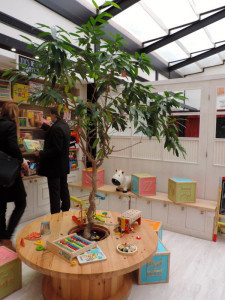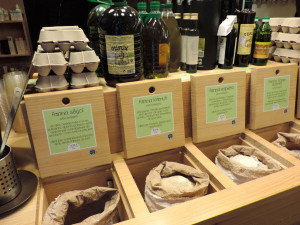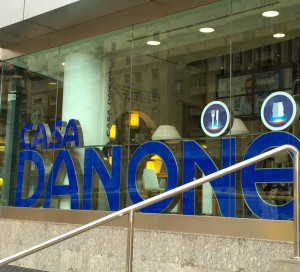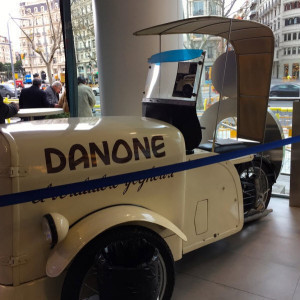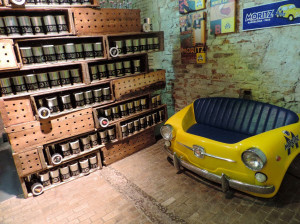Bryan Pearson's Blog, page 29
February 9, 2015
Five Innovative Barcelona Retailers Creating Muy Bueno Customer Experiences
When most people think of Barcelona, the first features that come to mind are its unusual architecture, rich history and Catalan cuisine. But the area is also home to a burgeoning class of “citi-sumers” who are fueling a vibrant and innovative retail resurgence. During a recent trip to attend BrandLoyalty’s bi-annual Retail Congress, several colleagues and I had the opportunity to visit five innovative retailers to see firsthand how their merchandising, marketing and product assortments are creating unique and memorable customer experiences.
Roca Gallery
Roca, one of the world’s leading brands in the bathroom sector, sells via 75 distributors in 18 countries. In 2009 the company built its flagship Roca Gallery Barcelona – a glass-encased showroom where social, cultural and expositional activities take place.
The experience of visiting the showroom is about as far as you could get from a trip to a typical North American hardware store to pick out toilets, sinks and faucets. Roca positions its high-end bathroom fixtures as jewels for its architects and individual customers. Every aspect of the showroom has been meticulously designed to feel like a museum – from the interactive digital displays to the typeface on the wall that accompany each Roca product to the company’s partnership with Armani.
Large visual screen s throughout the area depict customers interacting with Roca’s products juxtaposed with artistic videos built around the theme of “We Are Water.” Roca’s history, advertising and product specifications are accessible via interactive video screens in a choice of languages.
Baby Deli
This chain of health-conscious baby items, with locations in Barcelona, Madrid and Mexico, is the brainchild of four young entrepreneurial mothers who found opportunity in parents’ concerns about giving their children the best and teaching them to respect the environment. Their international experience in design, fashion, restaurants, law and teaching – combined with their knowledge of retailing in Europe and America – were fundamental to the launch of this innovative business concept.
Baby Deli sells environmentally friendly lifestyles through healthy food, sustainably sourced fashion and educational toys. Upon entering the store, customers are greeted by a small courtyard garden featuring a wooden train and a chalkboard that lists the educational seminars and events being held at the store.
Nearly every product can be touched and played with as parents and children relax in the in-store café to sample organic foods or enjoy a coffee. An expansive playroom area at the back of the store is used for educational events and can also be rented for children’s birthday parties.
Recognizing that the birth of a baby is often a catalyst for mothers to change their routines as well as their family’s eating habits, every aspect of the store is intended to provide inspiration on ecological awareness through healthy practices, organic products and responsible consumption.
Gra de Gracia (A Granel)
A visit to Gra de Gracia (A Granel) is like stepping back in time as the store looks to the past to recreate a buying experience that pre-dates packaged foods. The single-location store embodies the concept of “unbranding” as customers follow a three-step process: 1) choose a container, 2) fill it with what you need and 3) weigh it to determine the price.
Virtually all food is sold unpackaged and customers are encouraged to purchase only what they will use immediately, thus eliminating waste. Products as diverse as olive oil, tea and spices are displayed loose – in bins, clear containers, vats and baskets with virtually no packaging or branding, other than the name of the ingredient and the price. Only a few products are sold in original packaging, such as organic canned coconut milk and wine.
The knowledgeable store staff strive to create a sense of community for the slow shopping movement (making more sustainable purchasing decisions) by providing weekly meal plans, recipes and detailed information on product sourcing.
Casa Danone
The global brand Danone (Dannon) originated in Barcelona when Isaac Carasso – a Sephardic Jew – migrated from Thessaloniki, Greece, and named the business after his son Daniel. Casa Danone is the world-famous yogurt company’s first restaurant, opened in 2009 to celebrate Danone’s 90th anniversary.
Danone uses Casa Danone to connect its brand experience to the concept of health so that later, when customers visit the supermarket and see the Danone brands, they associate the name with good nutrition and value.
A far cry from traditional Catalonian fare, the restaurant features light and healthy food choices such as soups and salads alongside the frozen yogurt, which is made on site. Vintage Danone merchandise and memorabilia are prominently displayed and diners can visit the “yogurteria” where they customize their frozen yogurt experience with various toppings. Touchscreen kiosks share tidbits about the brand’s history.
Fabrica Moritz Barcelona
The oldest beer in Spain, Moritz established its Barcelona headquarters in the trendy Raval district in 1856. In 2004, the beer brand founded by Frenchman Louis Moritz Trautmann was relaunched as a local brand, in strong contrast to big international beer companies such as Heineken and Carlsberg.
As part of the relaunch, it opened its flagship Fabrica Mortiz, a brewery, bar and restaurant, has been described as a cultural gastronomic center, offering flavors and products that are directly connected with Barcelona and the people who live in the city. All beer produced at Fabrica Moritz is consumed on site with a vat-to-tap system that ensures freshness.
The building, on the site of the original factory, had been meticulously rebuilt by globally renowned architect Jean Nouvel, using original materials and updated technology. If beer isn’t your thing, the expansive location also houses a tapas and wine bar, the M-Store featuring a variety of Moritz-branded and quirky merchandise, a Triticum bakery, a newsstand and a multipurpose space that can be rented for corporate meetings, parties and cultural events including movie screenings and fashion shows.
Today Moritz is a cult brand that has built a following of ardent fans. It eschews traditional television and mass media advertising in favor of “marketing below the line” via sponsorships, cobranding (watches, bicycles, motorcycle helmets) and the vintage Moritz cars that salespeople drive around the city.
Key Themes
These five stores have a lot of wow factor, and they also rely on several common themes to appeal to Barcelona’s “citi-sumers” such as:
– They do not just sell products, they sell lifestyles (e.g. health, family or fun)
– Storytelling conveys product features and benefits as well as brand’s history
– They use natural elements within the retail locations – water, greenery, wood, original fixtures
– Following on the natural elements, they strive to be environmentally friendly or sustainable
Special thanks to COLLOQUY Editor Jill Z. McBride for reporting assistance and photography.
February 4, 2015
February 4: Loyalty Links & Likes
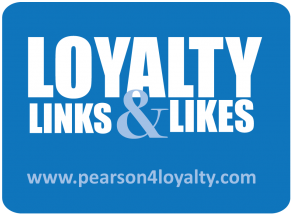 Using Smartphones and Apps to Enhance Loyalty Programs – The New York Times
Using Smartphones and Apps to Enhance Loyalty Programs – The New York Times
The age of smartphones has presented opportunities for small businesses to engage with customers on a scale previously reserved for larger companies. Loyalty apps not only allow businesses to automate certain administrative tasks, but also allow them to collect the data that helps them determine the effect their offerings have on the customer.
Customer Experience is the New Battleground for Winning Customer Loyalty – Business 2 Community
Larisa Bedgood puts it bluntly in this article about the customer experience: “you need your customers more than they need you.” Customers have access to more product options on more channels, so enhancing and personalizing the customer experience is more important than ever.
Embracing the Blur: How Luxury Retail Can Capture the Blended-Channel Consumer – COLLOQUY
COLLOQUY contributing editor and luxury retail expert Steven Dennis discusses the growing phenomenon of blended-channel customers – those who sometimes buy in-store, then buy from a website and shop on-the-go on their smartphone. To their detriment, many luxury brands have been slow to adapt to this channel-promiscuous customer.
How to Keep Your Customers Loyal Forever – Forbes
In this interview, Noah Fleming, author of Evergreen: Cultivate the Enduring Customer Loyalty that Keeps Your Business Thriving, argues that marketers need to reconceptualize their definition of marketing. It is equally about retaining customers as it is acquiring them.
CIOs Must Balance IT, Business Tech, Says Forrester’s George Colony – Wall Street Journal
George Colony, CEO of Forrester Research, told the crowd at the Wall Street Journal’s CIO Network event that chief information officers must balance the creation of business technologies with internal IT systems in order to win, serve and retain customers. While internal efficiency is important, the consumer-facing business technology can make or break a customer relationship.
February 2, 2015
Loyalty Limelight: My Coke Rewards
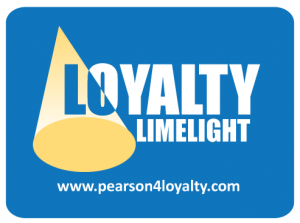 The Initiative: New My Coke Rewards, with two ways to earn
The Initiative: New My Coke Rewards, with two ways to earn
In a nutshell: My Coke Rewards launched in 2006 as one of the first consumer packaged goods programs. Based on a traditional points-accumulation model, it grants members a range of points for every Coke-branded product code entered online, which could then be redeemed for a wide selection of rewards. In late January, Coca-Cola updated the program to include a second, tiered path to earning rewards through activities.
Features: The new My Coke Rewards continues to offer members its traditional model of accumulating points through product purchases, but has complemented it with a second way to earn, and gain status, throughactivities. Members earn points by playing games, listening to music, completing surveys, watching videos, communicating through social media and participating in other activities. For example: Share a Coke experience with five people and get a free 20-ounce Coke product at Target.
All members, including existing members, start out in the bronze tier. Activities, not purchases, will earn them status toward the silver and gold tiers, though gaining silver status requires members link their social media accounts. As they earn their way up to the silver and gold tiers, members have access to a wider portfolio of rewards, from a broader range of egift cards to Shutterfly photo blankets.
The added features are essential to meet the evolving needs and expectations of Coca-Cola customers and partners, said Kim Gnatt global group director of digital marketing forCoca-Cola North America. “We needed a way to reward members for engaging with us in the social space and sharing our content; the status allows us to do that in a sustainable, scalable way.”
The Takeaways: Coke has grasped the effectiveness of activities in keeping members engaged with the brand for longer periods of time – and more time spent translates to more insights and opportunities to foster loyalty. Further, by encouraging members to share their Coke experiences, My Coke is setting a wave effect into motion, exposing the program and brand to a widening consumer group. Among the best practices:
• Tailored offers: Coke uses activity data and insights to better customize program experiences and rewards. If the member exhibits an interest in food or dining, for example, she might get a restaurant certificate.
• Surprises: Certain activities can unlock surprise catalog rewards and badges, lifting expectations and creating memorable moments. And marketers know that memorable brand experiences are more likely to be shared socially.
• Higher capture rate: By enabling existing members to continue earning points through purchases, My Coke has managed to introduce change without requiring it. Members who eschew social media can continue to earn by purchasing Coke products.
One caveat: Even the most active users of Facebook and Twitter may not be comfortable linking their accounts to a brand. My Coke’s team should be prepared to hear from those members who feel this requirement is a barrier to entry.
January 28, 2015
January 28: Loyalty Links & Likes
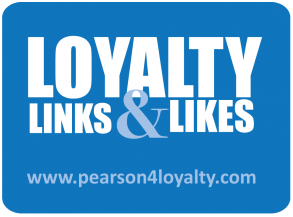 The Next Step for the Mobile Wallet? Loyalty Programs – Wall Street Journal
The Next Step for the Mobile Wallet? Loyalty Programs – Wall Street Journal
The biggest challenge mobile payments have faced since their inception is achieving widespread adoption. With the launch of Apple Pay, ubiquity is becoming reality, so what’s next? Industry experts believe the next natural step for this platform is to incorporate loyalty programs.
Gamifying Your Loyalty Program – Hospitality Net
One of the hot trends in customer loyalty in 2015 is to increase customer engagement through experiences. The addition of game mechanics to a program can help to achieve these engagement goals by making the program fun, sometimes even addicting – and the effect it has on a brand can be priceless.
NRF Round Up: Insights on Retail, Technology, Loyalty and More – COLLOQUY
This year’s NRF Big Show brought together 33,000 business professionals seeking to improve the retail customer experience. These 10 articles from COLLOQUY reporter Lisa Biank Fasig offer insights on retail, technology, loyalty and more from the brightest minds in the industry.
5 Effective (And Cost Efficient) Ways to Reward Loyal Customers – Business 2 Community
Rewarding customers for their continuing loyalty doesn’t have to cost an arm and a leg. Even if your business doesn’t offer a formal customer loyalty program, there are still cost-efficient ways to show them you appreciate their allegiance.
Shopping for Better Data – Forbes
Forbes contributor Andy Ellwood believes that 2015 will be a year of change for shoppers. Emerging technologies seek to engage with consumers in different ways, and this presents an opportunity for retailers to leverage data sets they may have not had access to before.
January 26, 2015
Nespresso Personalization Grinds Out Competition
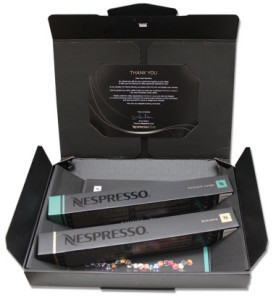 When it comes to stimulating consumer interest, loyalty marketers have become quite adept at brewing up ideas. Few of these ideas, however, resonate with the consumer to the point of clouding out convenient competition.
When it comes to stimulating consumer interest, loyalty marketers have become quite adept at brewing up ideas. Few of these ideas, however, resonate with the consumer to the point of clouding out convenient competition.
Few, but some do. Recently, Nespresso achieved relevance in spades, and pods, through personalization.
For those unaware, Nespresso is a home-order coffee service that involves a compact brewer and a broad selection of color-coded pods. I joined the Nespresso Club, which is available to those who purchase the machine and order the pods, in 2010. Since then, I’ve probably ordered hundreds of sleeves of coffee pods, most being the more robust blends.
I also am a member of the My Starbucks Rewards program, through which I earn “Stars” toward free drinks when paying with my Starbucks card or app. Additionally I get a free birthday drink and free in-store refills and custom offers. But no offer by Starbucks has been nearly as customized as a package I recently received from Nespresso
The box, labeled with the Nespresso logo, included two sleeves of coffee pods, neither of which I’ve tried. The package also included a drink recipe involving one of the blends.
“As a thank you for your continuous loyalty, we are happy to offer you two sleeves of coffee especially selected for you,” the included note stated. Identifying me as “an amateur of intense blends,” Nespresso sent me coffees both rich and full-bodied, suiting my preferences. The only shortfall: The note, signed by Nespresso Club Director Anne Gillam, was not addressed to me by name.
Nevertheless, the package made for an experience I will remember, more so than any of my Starbuck’s interactions. The My Starbucks program is without doubt an ingenious marketing strategy. By linking its rewards to a Starbucks-branded payment card or app, it has created a conditioning mechanism that ensures a high capture rate. However, I have yet to be inspired by its efforts to know me.
When I enter a Starbucks, no one acknowledges my regular order. Other than birthday specials, the chain does not send me surprise gifts that reflect my preferences. Even when it sends me regular reminders to reload my card, Starbucks does not offer me so much as a cup of coffee as an incentive.
That’s a missed opportunity, particularly in the context of receiving these Nespresso pods. The My Starbucks program is capturing data, but in my case it is not using those insights to delight me. The program is not doing what loyalty initiatives are designed to do – to support a platform that enables the brand to learn and share, to encourage desired consumer behavior through relevant, personalized experiences.
I’d suggest three simple guidelines for achieving that:
1: Know why: Determine why your best customers choose your brand. This feedback can be gathered in a number of ways, including post-purchase online surveys, in-store employee feedback and a simple question on loyalty program registrations.
2: Know what: Once a company understands why its best shoppers choose it over others, it can get tactical. This means collecting only the data required to better understand and serve those preferences and then putting it to work in ways that noticeably benefit the customer.
3: Know how: People have different expectations among brands because they use them in different ways, at different times of day and have varying emotional affiliations. When it comes to getting coffee, for example, I expect good flavor, some camaraderie and a positive vibe to start my day positively. When I am buying electronics, I want expertise, respect and an appreciation of my technological prowess. Using loyalty data, brands can determine when to send communications and surprises that align with the expected brand experience, how to send them, and the frequency with which to do it.
Which is what Nespresso nailed down. The team rewarded my loyalty in a way that brought me a little bit closer to the brand, through their small effort to simply recognize the preferences I so clearly demonstrate via my purchase behavior. I’ve ordered more pods, and plan on taking more of my coffee business in-house.
January 21, 2015
January 21: Loyalty Links & Likes
 Customer-Centricity Is Mandatory for 2015 – Huffington Post
Customer-Centricity Is Mandatory for 2015 – Huffington Post
2015 is set to be the year of customer-focused strategies for all companies looking to increase retention. This article offers three examples of companies that are doing it right.
How to Tap the Power of Social Media to Forge Customer Loyalty – Entrepreneur
Customer loyalty is often determined by the experiences consumers have each time they interact with a brand, and this includes online experiences. So why are only 20% of chief marketing officers making the most of social channels?
The Year in Review: Top Financial Stories of 2014 – COLLOQUY
This special report from COLLOQUY takes a look back at the top loyalty marketing stories from the financial services industry over the past year. These articles, breaking news stories, infographics and interviews helped to define the industry in 2014.
Taming the Big Data Beast: The Importance of CRM – Tech Radar
The huge amounts of data collected from both online and offline resources these days can be extremely valuable for making intelligent business decisions, but it can also be an unwieldy beast. When this data is incorporated into a CRM tool available to customer-facing employees, the benefits can be astounding.
Want a Powerful Customer Experience? Make It Easy for the Customer – Forbes
A streamlined in-store customer experience goes a long way towards happy customers, but complicated and unhelpful service experiences can turn a customer off to a brand. Companies that strive to improve the customer experience make themselves easily accessible on all preferred channels of communication.
January 19, 2015
Missing the Target in Canada: Four Steps to Capitalizing on Its Loss
 There are many things a loyalty-marketing platform can resolve for a brand, but as Target recently demonstrated with its expensive failure in Canada, it cannot rebuild a weak foundation.
There are many things a loyalty-marketing platform can resolve for a brand, but as Target recently demonstrated with its expensive failure in Canada, it cannot rebuild a weak foundation.
Much has been written about the pullout; it is in many ways a case study in marketing 101. Canada represented Target’s first international market, yet the value-priced merchant approached the region as if it had owned it, barreling across the country with 124 stores in roughly a year. But the physical expansion was less of an issue than Target’s execution against the core brand proposition Canadians had come to expect from either their own shopping experiences in the U.S. or from Target’s strong reputation.
Target launched with the tagline: “Expect More. Pay Less.” But the unique private-label offerings brought to market by signature designers – one of the chain’s key draws – seemed to stall in Canada. Combine that with some poor locations, supply chain issues and higher prices than expected, and we have a foundational value problem.
So it is no surprise that while Target operated its REDcard loyalty program in Canada, it was not effective in supporting an already challenging situation. At LoyaltyOne, we have always said a great loyalty initiative will rarely make up for a struggling brand that doesn’t get the basics right. And despite a population that is very receptive to loyalty programs, I am left uncertain as to whether the program ever gained traction considering the stores failed to be relevant in the first place.
However, now that Target has made its decision to abandon the market, perhaps the other retailers in Canada can take a page from the Loyalty Marketers handbook and take advantage of the data assets they have built up over the years.
1. Analyze your data to figure out which customers may have changed their shopping patterns upon the launch of Target.
2. Determine what they were purchasing elsewhere. What categories do you need to focus on in the future?
3. Target the customers with engaging offers that are customized to their existing and potential buying behaviors. Don’t just send them stuff they are not buying, but instead embed these offers within a series of promotions that reflect what the customer is buying today. This will capture more attention and enrich engagement.
4. Look at what this can tell you about the future. Do you need to shore up your offerings in specific categories? Are there additional ways to deepen engagement with your customers by building a new value proposition that changes the way they think about your brand?
By taking these four steps, marketers can reinforce the foundations of their brands and, more importantly, insulate them from the threat of future “Targets” yet to come.
January 14, 2015
January 14: Loyalty Links & Likes
 Three Customer Loyalty Lessons From Coffee Companies: Only One is Good – Forbes
Three Customer Loyalty Lessons From Coffee Companies: Only One is Good – Forbes
Forbes contributor Roger Dooley explains how some loyalty marketing initiatives from coffee companies Starbucks, Keurig and Nespresso are brilliant, while some leave a bitter taste in the consumer’s mouth.
8 Reasons Why Loyalty Programs are Imperative for Marketers – Marketing Land
Loyalty programs are more widespread and ubiquitous than ever. Marketing Land offers eight reasons why loyalty programs are so important – in the case that any holdouts still aren’t convinced.
The Year in Review: Top Retail Stories of 2014 – COLLOQUY
This special report from COLLOQUY takes a look back at the top loyalty marketing stories from the retail industry over the past year. These articles, breaking news stories, infographics and interviews helped to define the industry in 2014.
5 Ways to Strengthen Customer Loyalty – Business 2 Community
Every business knows the basics of getting return customers – offer consistently high quality products, services and experiences. There are other ways, however, to build a brand and increase sales, both online and off. This article offers five tips to deepen customer loyalty.
CIOs Must Sharpen Customer Experience Strategy – CIO Insight
In the age of smartphones and the connected customer, it’s becoming much more important for the chief information officer to be involved in determining a company’s customer experience strategy. Companies now have the opportunity to receive continuous customer feedback from numerous channels, and the IT infrastructure must be in place for them to capture it.
January 12, 2015
Uber and Managing the Surge: Using Data to Involve Customers
 There is a saying about the ugly side of business that warns us against watching how sausage is made. These days, the ride-service company Uber is not only revealing its behind-the-scenes process, it also is inviting its riders into the grind – with attractive results.
There is a saying about the ugly side of business that warns us against watching how sausage is made. These days, the ride-service company Uber is not only revealing its behind-the-scenes process, it also is inviting its riders into the grind – with attractive results.
The app-based service, recently criticized for surge pricing during high-demand times, is stepping in front of the issue and explaining not only why price hikes occur, but how Uber customers can help manage them. I received an email from Team Uber on New Year’s Eve explaining so much as it approached what would likely be its biggest night in Toronto, with more than 2 million rides.
“Busy nights require surge pricing to get enough cars on the road and ensure you always have a reliable ride,” Team Uber wrote.
The letter then detailed what would be the most expensive times to reserve a ride – 12: 30 to 2:30 a.m. – and suggested customers catch a ride right when the ball drops or a few hours later, when prices to “return to normal.”
“Don’t forget: you’ll always be notified in advance and asked to confirm any increased rates, and you can always estimate your fare before requesting,” the letters states, also suggesting customers share the ride and split the fare.
I appreciate many things about this letter, but what I love is how Uber uses its data to help customers understand its service offering and the significant demand curves that may take place. Uber is essentially doing something very simple – sharing key elements about its business with customers, but in a way that encourages them to help manage its own product limitations.
Other companies have exhibited similar transparencies when it comes to making major changes, or recognizing their limitations. In July, Spirit Airlines began giving away 1 billion Free Spirit frequent flyer miles to members who felt wronged by the carrier. The promotion, called the “Hate Thousand Miles Giveaway,” bestows 8,000 miles at a time to Free Spirit members who shared their terrible air travel stories at HateThousandMiles.com.
“We want to change the way people think about air travel and educate them about the Spirit way of traveling” Ben Baldanza, CEO of Spirit Airlines, said in a press release.
Similarly the fast food chain Arby’s, in its “We Have Pepsi” campaign, created commercials featuring Pepsi with a voice over stating that because Arby’s carries Pepsi, it is under contract to promote the beverage in ads twice a year.
But these efforts, while illuminating the practical challenges and requirements of their industries, stop short of inviting customers to help manage inventory or product limitations. By doing this, Uber invites its customers to be one with the business.
It may bring a new meaning to how the sausage is made.
January 7, 2015
January 7: Loyalty Links & Likes
 Consumers Advice for 2015: Your Brand’s Loyalty Program is the Wrong Way Round – Customer Think
Consumers Advice for 2015: Your Brand’s Loyalty Program is the Wrong Way Round – Customer Think
Sometimes brand loyalty can be confused with the consumers’ preference for the attributes, experience or category of a company’s offering, rather than the brand itself. To change this, brands need to shift strategies to focus on being loyal to their customers, as opposed to the other way around.
Sony Hack Hurts More Than Star’s Egos: Brand Loyalty Takes a Hit – New York Post
The recent computer hacks on Sony exposed confidential information that damaged the reputation of company executives as well as some celebrities working on movies produced by the studio. The unexpected damage, however, comes in the form of brand reputation and reliability.
The Year in Review: Top 14 Loyalty Marketing Stories of 2014 – COLLOQUY
A look at some of the top stories in loyalty marketing over the last year, which ranged from major partnerships and program shifts to emerging technologies and loyalty strategies.
Jeff Fromm and Cherryh Butler: Three Ways to Inspire Millennial Loyalty – PSFK
Millennials are a skeptical generation. They are weary of advertising and only give up valuable information if they truly trust a brand. Companies can lure in these valuable consumers by being transparent, clearly stating their value and leveraging customer data.
5 Traits of Customer-Focused Companies – Business 2 Community
In order to become a company that is customer-focused, there are a few important aspects of the business that must be considered. In addition to actually expending the appropriate resources, it’s important to make sure key stakeholders are also on board.
Bryan Pearson's Blog
- Bryan Pearson's profile
- 4 followers


